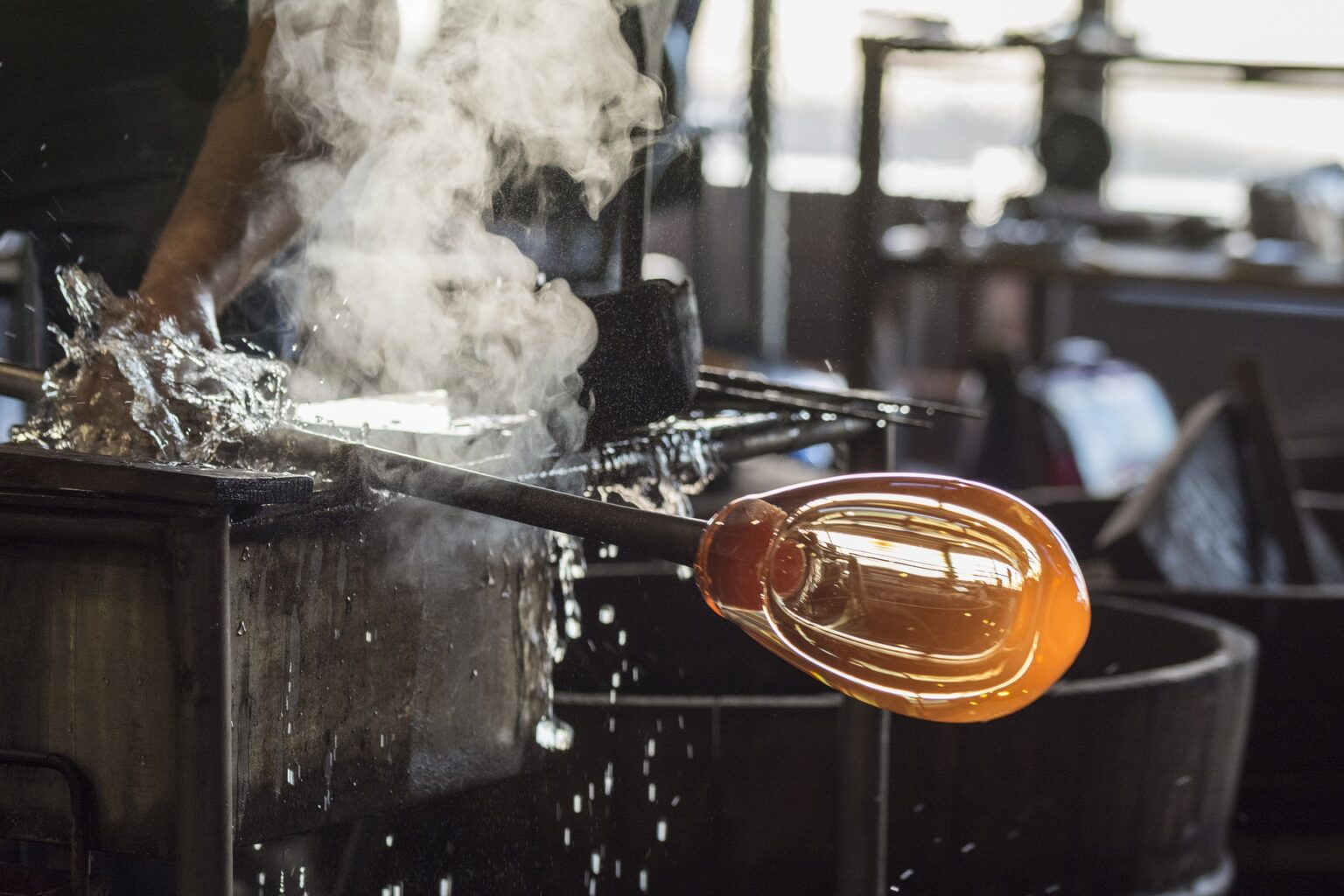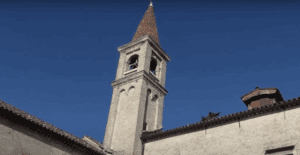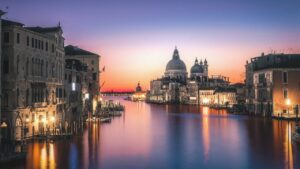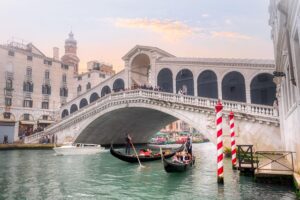Murano Glass — The Island Where Fire and Art Become One
Just a short boat ride from Venice lies Murano — a small island that glows with centuries of craftsmanship, color, and creativity. For more than 700 years, this quiet corner of the lagoon has been home to the world’s most famous glassmakers, transforming molten sand and fire into shimmering works of art.
Today, visiting Murano is one of the most unforgettable experiences in Venice. You’ll hear the hiss of furnaces, watch artisans breathe life into liquid glass, and discover how an ancient tradition still burns bright in the 21st century.
🏛️ The History of Murano Glass
Venetian glassmaking began as early as the 8th century, when local craftsmen created mirrors, beads, and fine tableware that were traded across Europe. But in 1291, the Venetian Republic issued a decree that changed history: to protect the city’s wooden buildings from fire, all glass furnaces were moved to Murano — a small island just north of Venice.
Isolated from the mainland, Murano’s artisans became both guardians and innovators. Their techniques were closely guarded secrets, passed down through families for generations. Over time, Murano glass became synonymous with luxury and refinement — adorning royal palaces, cathedrals, and noble homes across the world.
Some of these traditions are still alive today, especially through hands-on experiences like our Murano Workshop & Glassblowing Visit, where visitors can watch masters at work and even try blowing glass themselves.
🧑🏭 Secrets of the Furnace — Techniques That Made Murano Famous
What makes Murano glass truly exceptional is not just its beauty, but the skill behind it. For centuries, glassmakers here have developed and refined specialized techniques that continue to amaze both collectors and visitors.
- Millefiori (“a thousand flowers”): Colorful glass canes sliced into tiny sections and fused together to form intricate floral patterns.
- Filigrana: Delicate glass threads twisted into lace-like designs inside clear glass objects.
- Incalmo: A complex technique for joining multiple sections of glass in different colors while hot.
- Avventurina: Sparkling metallic inclusions that shimmer like stars inside the glass — a Murano invention from the Renaissance.
- Enameling and engraving: Hand-painted and hand-cut decorations applied after the glass cools.
Each technique requires precision, speed, and years of apprenticeship. Watching a master glassblower create a vase or sculpture feels almost like witnessing magic — one breath, one twist, and a glowing blob becomes a masterpiece.
🔥 How Murano Glass Is Made — From Sand to Sculpture
The process of creating Murano glass is both ancient and exacting. It begins with a simple mix of silica sand, soda, lime, and minerals — melted in furnaces that reach over 1,400°C (2,550°F). Once molten, the glowing glass is shaped using a combination of tools, molds, and breath.
Artisans roll, twist, and blow the material with perfect timing — seconds matter. If the temperature drops too fast, the glass hardens. Too hot, and it collapses. Each workshop has its own secret formulas for colors, from deep ruby to aquamarine and gold-flecked amber.
Visitors can see this process up close on our Glass Bead Lampwork Experience, or during a private Venice Lagoon Tour that includes Murano’s most authentic studios.
🏝️ Murano Today — A Living Legacy
While industrial glass production has moved elsewhere, Murano remains the beating heart of artistic glass. The island’s furnaces are family-run workshops where generations continue the craft with pride and innovation. Some studios blend tradition with contemporary design, collaborating with international artists and luxury brands.
At Vivarini Glass, one of Murano’s most renowned studios, visitors can explore the fusion of ancient glassmaking with modern design — from bespoke eyewear to sculpture. We collaborate directly with their artisans to offer private demonstrations, exclusive pieces, and complimentary transfers for our guests.
🕍 What to See and Do on Murano
- Glassblowing demonstrations: Step inside a working furnace and watch masters shape molten glass into art — an unforgettable sight.
- Museo del Vetro (Glass Museum): Housed in the Palazzo Giustinian, it traces 1,000 years of Venetian glassmaking. You can also book skip-the-line tickets.
- San Pietro Martire Church: A beautiful Gothic church filled with glass chandeliers and artworks by Bellini and Veronese.
- Glass boutiques and ateliers: From contemporary galleries to traditional shops, you’ll find exquisite pieces ranging from jewelry to monumental chandeliers.
Don’t miss a stop at Calle Bressagio, home to some of the oldest furnaces still in operation. And if you want a truly hands-on experience, join our Venetian Mask Workshop or Venice Hands-On Workshop series — they pair beautifully with a Murano glass visit.
🍝 Where to Eat in Murano
After exploring the furnaces, relax in one of Murano’s canalside trattorias or wine bars. Here are a few local favorites:
- Osteria al Duomo: A classic Murano spot with seafood risotto, grilled fish, and friendly service.
- Busa alla Torre: Traditional Venetian fare and a great wine list near the main canal.
- Trattoria ai Vetrai: Cozy, authentic, and often filled with glassmakers during lunch break.
Pair your meal with a crisp glass of Veneto Prosecco or, better yet, join us afterward for a Cicchetti & Wine Tour back in Venice — the perfect way to end a day surrounded by glass, water, and good company.
🚤 How to Visit Murano
Murano is easily accessible from Venice — about 15 minutes by private water taxi or 25 minutes by vaporetto (water bus) from Fondamente Nove or San Zaccaria. You can also visit as part of our Island-Hopping Excursion, which includes Murano, Burano, and Torcello with a private local guide.
For the best experience, plan to visit early morning before the groups arrive — or late afternoon, when the light over the lagoon turns golden. Many furnaces close for lunch (usually between 1–2 p.m.), so time your visit accordingly.
🎁 What to Buy — and How to Recognize Authentic Murano Glass
True Murano glass carries a certificate of authenticity and often a “Vetro Artistico Murano” sticker issued by the Venetian authorities. Avoid cheap imitations sold in tourist shops around St. Mark’s — they’re often mass-produced elsewhere.
Instead, buy directly from certified studios on the island or visit with us — our guides know the artisans personally and can introduce you to family-run workshops that don’t usually open to the public.
✨ Final Thoughts — The Spirit of Fire and Water
Murano is more than an island — it’s a living museum where centuries of passion and artistry still burn within every flame. Watching glass take shape here feels like witnessing Venice itself being reborn, one bubble at a time.
Whether you take home a delicate glass bead or a grand chandelier, you’re bringing back a piece of history — and a reminder that some traditions truly never fade. Join us for a Murano Glassblowing Experience or Lagoon Tour and discover the magic that has made Murano famous around the world.
FAQs About Murano Glass
How do I visit Murano from Venice?
Murano is just a 15-minute private boat ride or a 25-minute vaporetto trip from central Venice. The easiest way to visit is with our Murano Workshop and Visit — Discover the Art of Glassblowing, which includes demonstrations, artisan introductions, and private transfers directly from your hotel or pier.
Can I try glassblowing myself in Murano?
Yes! You can experience the craft firsthand during our Create Your Own Glass Bead — Discover the Art of Lampwork workshop. Guided by master artisans, you’ll shape molten glass and learn the secrets behind Murano’s legendary techniques like millefiori and filigrana.
How can I tell if Murano glass is authentic?
Genuine Murano glass carries a Vetro Artistico® Murano certification or proof of origin from an island workshop. Avoid cheap replicas in souvenir shops near St. Mark’s. For peace of mind, join our Venice Tour of the Lagoon — Discover the Hidden Gems — we visit only verified, family-run furnaces that maintain centuries-old traditions.







